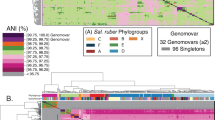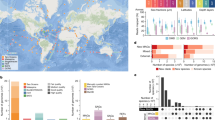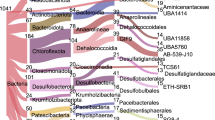Abstract
Microorganisms represent the largest reservoir of biodiversity on Earth, both in numbers and total genetic diversity, but it remains unclear whether this biodiversity is organized in discrete units that correspond to ecologically coherent species. To further explore this question, we examined patterns of genomic diversity in sympatric microbial populations. Analyses of a total of ∼200 Mb of microbial community genomic DNA sequence recovered from 4000 m depth in the Pacific Ocean revealed discrete sequence-defined populations of Bacteria and Archaea, with intrapopulation genomic sequence divergence ranging from ∼1% to ∼6%. The populations appeared to be maintained, at least in part, by intrapopulation genetic exchange (homologous recombination), although the frequency of recombination was estimated to be about three times lower than that observed previously in thermoacidophilic archaeal biofilm populations. Furthermore, the genotypes of a given population were clearly distinguishable from their closest co-occurring relatives based on their relative abundance in situ. The genetic distinctiveness and the matching sympatric abundances imply that these genotypes share similar ecophysiological properties, and therefore may represent fundamental units of microbial diversity in the deep sea. Comparisons to surface-dwelling relatives of the Sargasso Sea revealed that distinct sequence-based clusters were not always detectable, presumably due to environmental variations, further underscoring the important relationship between environmental contexts and genetic mechanisms, which together shape and sustain microbial population structure.
Similar content being viewed by others
Log in or create a free account to read this content
Gain free access to this article, as well as selected content from this journal and more on nature.com
or
Accession codes
References
Acinas SG, Klepac-Ceraj V, Hunt DE, Pharino C, Ceraj I, Distel DL et al. (2004). Fine-scale phylogenetic architecture of a complex bacterial community. Nature 430: 551–554.
Altschul SF, Madden TL, Schaffer AA, Zhang J, Zhang Z, Miller W et al. (1997). Gapped BLAST and PSI-BLAST: a new generation of protein database search programs. Nucl Acids Res 25: 3389–3402.
Cohan FM . (2002). What are bacterial species? Annu Rev Microbiol 56: 457–487.
Coleman ML, Sullivan MB, Martiny AC, Steglich C, Barry K, Delong EF et al. (2006). Genomic islands and the ecology and evolution of Prochlorococcus. Science 311: 1768–1770.
DeLong EF, Preston CM, Mincer T, Rich V, Hallam SJ, Frigaard NU et al. (2006). Community genomics among stratified microbial assemblages in the ocean's interior. Science 311: 496–503.
DeLong EF, Wu KY, Prezelin BB, Jovine RV . (1994). High abundance of Archaea in Antarctic marine picoplankton. Nature 371: 695–697.
Eppley JM, Tyson GW, Getz WM, Banfield JF . (2007). Genetic exchange across a species boundary in the archaeal genus Ferroplasma. Genetics 177: 407–416.
Feil EJ, Holmes EC, Bessen DE, Chan MS, Day NP, Enright MC et al. (2001). Recombination within natural populations of pathogenic bacteria: short-term empirical estimates and long-term phylogenetic consequences. Proc Natl Acad Sci USA 98: 182–187.
Felsenstein J . (2004). PHYLIP (Phylogeny Inference Package), version 3.6. Distributed by the author. Department of Genome Sciences, University of Washington: Seattle.
Fraser C, Hanage WP, Spratt BG . (2007). Recombination and the nature of bacterial speciation. Science 315: 476–480.
Garcia Martin H, Ivanova N, Kunin V, Warnecke F, Barry KW, McHardy AC et al. (2006). Metagenomic analysis of two enhanced biological phosphorus removal (EBPR) sludge communities. Nat Biotechnol 24: 1263–1269.
Giovannoni SJ, Britschgi TB, Moyer CL, Field KG . (1990). Genetic diversity in Sargasso Sea bacterioplankton. Nature 345: 60–63.
Goris J, Konstantinidis KT, Klappenbach JA, Coenye T, Vandamme P, Tiedje JM . (2007). DNA-DNA hybridization values and their relationship to whole-genome sequence similarities. Int J Syst Evol Microbiol 57: 81–91.
Green P . (2006). Phrap-Phred Assembly Software. Distributed by the author. Genome Sciences Department, University of Washington: Seattle.
Hallam SJ, Konstantinidis KT, Putnam N, Schleper C, Watanabe Y, Sugahara J et al. (2006a). Genomic analysis of the uncultivated marine crenarchaeote Cenarchaeum symbiosum. Proc Natl Acad Sci USA 103: 18296–18301.
Hallam SJ, Mincer TJ, Schleper C, Preston CM, Roberts K, Richardson PM et al. (2006b). Pathways of carbon assimilation and ammonia oxidation suggested by environmental genomic analyses of marine Crenarchaeota. PLoS Biol 4: e95.
Hanage WP, Fraser C, Spratt BG . (2005). Fuzzy species among recombinogenic bacteria. BMC Biol 3: 6.
Karner MB, DeLong EF, Karl DM . (2001). Archaeal dominance in the mesopelagic zone of the Pacific Ocean. Nature 409: 507–510.
Konstantinidis KT, Ramette A, Tiedje JM . (2006). The bacterial species definition in the genomic era. Philos Trans R Soc Lond B Biol Sci 361: 1929–1940.
Konstantinidis KT, Tiedje JM . (2005). Genomic insights that advance the species definition for prokaryotes. Proc Natl Acad Sci USA 102: 2567–2572.
Konstantinidis KT, Tiedje JM . (2007). Prokaryotic taxonomy and phylogeny in the genomic era: advancements and challenges ahead. Curr Opin Microbiol 10: 504–509.
Kosakovsky Pond SL, Posada D, Gravenor MB, Woelk CH, Frost SD . (2006a). Automated phylogenetic detection of recombination using a genetic algorithm. Mol Biol Evol 23: 1891–1901.
Kosakovsky Pond SL, Posada D, Gravenor MB, Woelk CH, Frost SD . (2006b). GARD: a genetic algorithm for recombination detection. Bioinformatics 22: 3096–3098.
Lam P, Jensen MM, Lavik G, McGinnis DF, Muller B, Schubert CJ et al. (2007). Linking crenarchaeal and bacterial nitrification to anammox in the Black Sea. Proc Natl Acad Sci USA 104: 7104–7109.
Lawrence JG . (2002). Gene transfer in bacteria: speciation without species? Theor Popul Biol 61: 449–460.
Martin DP, Williamson C, Posada D . (2005). RDP2: recombination detection and analysis from sequence alignments. Bioinformatics 21: 260–262.
McVean G, Awadalla P, Fearnhead P . (2002). A coalescent-based method for detecting and estimating recombination from gene sequences. Genetics 160: 1231–1241.
Moran NA . (2007). Symbiosis as an adaptive process and source of phenotypic complexity. Proc Natl Acad Sci USA 104 (Suppl 1): 8627–8633.
Nesbo CL, Dlutek M, Doolittle WF . (2006). Recombination in Thermotoga: implications for species concepts and biogeography. Genetics 172: 759–769.
Palys T, Berger E, Mitrica I, Nakamura LK, Cohan FM . (2000). Protein-coding genes as molecular markers for ecologically distinct populations: the case of two Bacillus species. Int J Syst Evol Microbiol 50 (Part 3): 1021–1028.
Pham VD, Konstantinidis KT, Palden T, DeLong EF . (2008). Phylogenetic analyses of ribosomal DNA-containing bacterioplankton genome fragments from a 4000 m vertical profile in the North Pacific Subtropical Gyre. Environ Microbiol (doi:10.1111/j.1462-2920.2008.01657.X).
Rappe MS, Giovannoni SJ . (2003). The uncultured microbial majority. Annu Rev Microbiol 57: 369–394.
Rusch DB, Halpern AL, Sutton G, Heidelberg KB, Williamson S, Yooseph S et al. (2007). The Sorcerer II global ocean sampling expedition: Northwest Atlantic through Eastern Tropical Pacific. PLoS Biol 5: e77.
Sabehi G, Beja O, Suzuki MT, Preston CM, DeLong EF . (2004). Different SAR86 subgroups harbour divergent proteorhodopsins. Environ Microbiol 6: 903–910.
Sheppard SK, McCarthy ND, Falush D, Maiden MC . (2008). Convergence of Campylobacter species: implications for bacterial evolution. Science 320: 237–239.
Sorek R, Zhu Y, Creevey CJ, Francino MP, Bork P, Rubin EM . (2007). Genome-wide experimental determination of barriers to horizontal gene transfer. Science 318: 1449–1452.
Spratt BG, Hanage WP, Feil EJ . (2001). The relative contributions of recombination and point mutation to the diversification of bacterial clones. Curr Opin Microbiol 4: 602–606.
Staley JT . (2006). The bacterial species dilemma and the genomic-phylogenetic species concept. Philos Trans R Soc Lond B Biol Sci 361: 1899–1909.
Thompson JD, Higgins DG, Gibson TJ . (1994). CLUSTAL W: improving the sensitivity of progressive multiple sequence alignment through sequence weighting, position-specific gap penalties and weight matrix choice. Nucleic Acids Res 22: 4673–4680.
Thompson JR, Pacocha S, Pharino C, Klepac-Ceraj V, Hunt DE, Benoit J et al. (2005). Genotypic diversity within a natural coastal bacterioplankton population. Science 307: 1311–1313.
Tringe SG, von Mering C, Kobayashi A, Salamov AA, Chen K, Chang HW et al. (2005). Comparative metagenomics of microbial communities. Science 308: 554–557.
Tyson GW, Chapman J, Hugenholtz P, Allen EE, Ram RJ, Richardson PM et al. (2004). Community structure and metabolism through reconstruction of microbial genomes from the environment. Nature 428: 37–43.
Venter JC, Remington K, Heidelberg JF, Halpern AL, Rusch D, Eisen JA et al. (2004). Environmental genome shotgun sequencing of the Sargasso Sea. Science 304: 66–74.
Vulic M, Dionisio F, Taddei F, Radman M . (1997). Molecular keys to speciation: DNA polymorphism and the control of genetic exchange in enterobacteria. Proc Natl Acad Sci USA 94: 9763–9767.
Ward DA . (2006). A macrobiological perspective on microbial species. Microbe Mag 1: 269–278.
Zawadzki P, Roberts MS, Cohan FM . (1995). The log-linear relationship between sexual isolation and sequence divergence in Bacillus transformation is robust. Genetics 140: 917–932.
Acknowledgements
We are grateful to Virginia Rich and Gene Tyson for helpful discussions regarding the manuscript and Sergei Kosakovsky, Gilean McVean and Thierry Wirth for their help with GARD and LDhat. We also thank Chris Preston, Lynne Christianson and Professor David Karl, and the Hawaii Ocean Time series staff and crew for assistance in sample collection at station ALOHA. We thank the JGI production sequencing staff for whole fosmid and shotgun sequencing. This work was supported by the Gordon and Betty Moore Foundation, Department of Energy Microbial Genome Sequencing program, US Department of Energy's Office of Science, Biological and Environmental Research Program and the University of California, Lawrence Livermore National Laboratory, under contract no. W-7405-ENG-48, Lawrence Berkeley National Laboratory under contract no. DE-AC03-765F00098 and Los Almos National Laboratory contract no. W-7405-ENG-36.
Author information
Authors and Affiliations
Corresponding author
Additional information
Data release The genomic scaffold used in Figure 1 is provided as a supplementary fasta-formated file. All fully sequenced fosmids and the WGS data from 4000-m depth sample are now available in GenBank under the accession numbers: EU016559–EU016674 and ABEF00000000, respectively.
Supplementary Information accompanies the paper on The ISME Journal website (http://www.nature.com/ismej)
Supplementary information
Rights and permissions
About this article
Cite this article
Konstantinidis, K., DeLong, E. Genomic patterns of recombination, clonal divergence and environment in marine microbial populations. ISME J 2, 1052–1065 (2008). https://doi.org/10.1038/ismej.2008.62
Received:
Revised:
Accepted:
Published:
Issue date:
DOI: https://doi.org/10.1038/ismej.2008.62
Keywords
This article is cited by
-
Reply to: “Re-evaluating the evidence for a universal genetic boundary among microbial species”
Nature Communications (2021)
-
Genomic diversity landscape of the honey bee gut microbiota
Nature Communications (2019)
-
Quantifying the changes in genetic diversity within sequence-discrete bacterial populations across a spatial and temporal riverine gradient
The ISME Journal (2019)
-
Contrasting patterns of genome-level diversity across distinct co-occurring bacterial populations
The ISME Journal (2018)
-
Genomic divergence and cohesion in a species of pelagic freshwater bacteria
BMC Genomics (2017)



